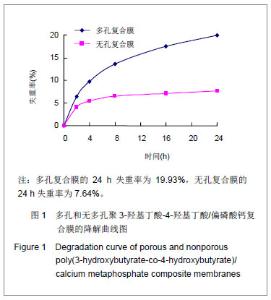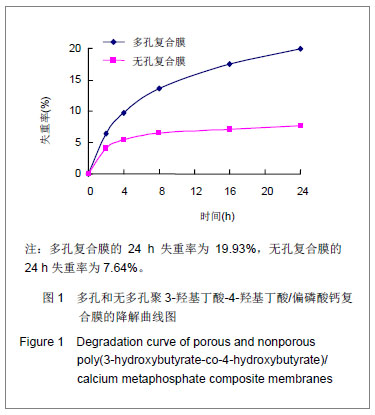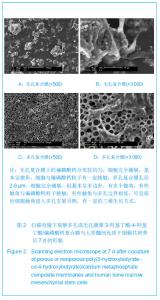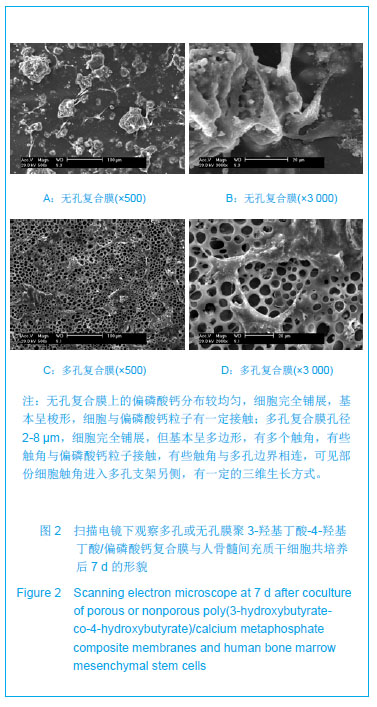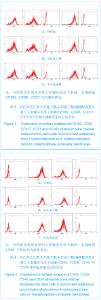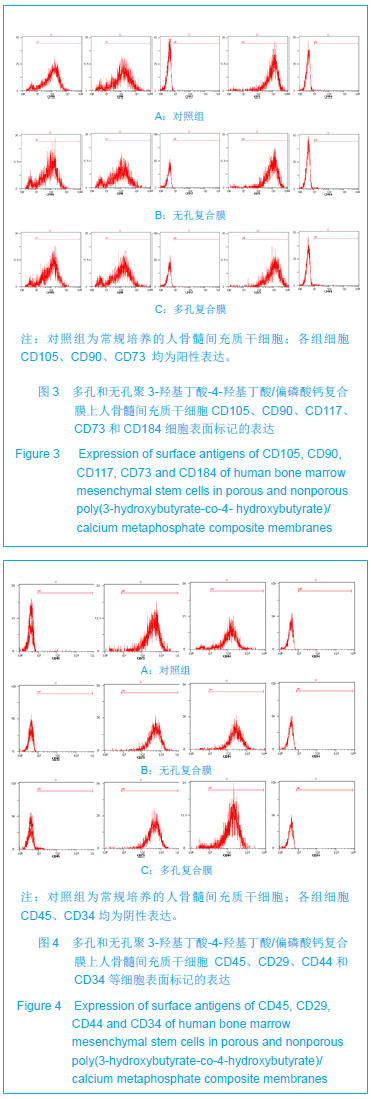Chinese Journal of Tissue Engineering Research ›› 2013, Vol. 17 ›› Issue (34): 6123-6130.doi: 10.3969/j.issn.2095-4344.2013.34.010
Previous Articles Next Articles
Preparation and cytocompatibility of novel porous calcium metaphosphate composite membranes
Wu Yue-heng1, Chen Peng2, Mai Li-ping1, Zhang Ling-min2, Tang Shun-qing2, Yu Xi-yong1
- 1Medical Research Center of Guangdong General Hospital, Guangdong Provincial Cardiovascular Institute, Guangdong Academy of Medical Sciences, Guangzhou 510100, Guangdong Province, China; 2Institute of Biomedical Engineering, Jinan University, Guangzhou 510632, Guangdong Province, China
-
Online:2013-08-20Published:2013-08-20 -
Contact:Yu Xi-yong, Professor, Doctoral supervisor, Medical Research Center of Guangdong General Hospital, Guangdong Provincial Cardiovascular Institute, Guangdong Academy of Medical Sciences, Guangzhou 510100, Guangdong Province, China yuxycn@hotmail.com -
About author:Wu Yue-heng★, Master, Assistant researcher, Medical Research Center of Guangdong General Hospital, Guangdong Provincial Cardiovascular Institute, Guangdong Academy of Medical Sciences, Guangzhou 510100, Guangdong Province, China edgar_wu@yahoo.com.cn -
Supported by:the National Natural Science Foundation of China, No. 30901468
CLC Number:
Cite this article
Wu Yue-heng, Chen Peng, Mai Li-ping, Zhang Ling-min, Tang Shun-qing, Yu Xi-yong. Preparation and cytocompatibility of novel porous calcium metaphosphate composite membranes[J]. Chinese Journal of Tissue Engineering Research, 2013, 17(34): 6123-6130.
share this article
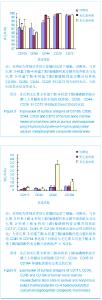
图3和图4流式细胞术检测结果,图5和图6是所测结果的分析。 图5是细胞表面标记CD105、CD90、CD44、CD29 和CD73的表达均为阳性表达。对图5的数据进行方差分析发现,所有上述细胞表面标记在正常对照组、多孔复合膜组和无孔复合膜组间比较差异无显著性意义。 图6是CD117、CD34、CD45和CD184等细胞表面标记的表达均为阴性表达。对图6的数据进行方差分析发现,CD117和CD34细胞表面标记在正常对照组、多孔复合膜组和无孔复合膜组间比较差异无显著性意义。CD45和 CD184细胞表面标记在正常对照组、多孔复合膜组和无孔复合膜组间比较差异有显著性意义(P ≤ 0.01)。进一步分析CD45、CD184上述3组之间的差异情况,分别对CD45、CD184上述3组之间采用S-N-K检验进行两两比较,结果发现,多孔复合膜组与正常对照组、无孔复合膜组之间比较差异有显著性意义(P ≤ 0.01),正常对照组和无孔复合膜组之间比较差异无显著性意义。 总之,CD105、CD90、CD44、CD29、CD73、CD117和CD34细胞表面标记在正常对照组、多孔复合膜组和无孔复合膜组间比较差异无显著性意义。多孔复合膜组CD45和CD184表达与正常对照组、无孔复合膜组之间比较差异有显著性意义(P ≤ 0.01),正常对照组和无孔复合膜组之间比较差异无显著性意义。"
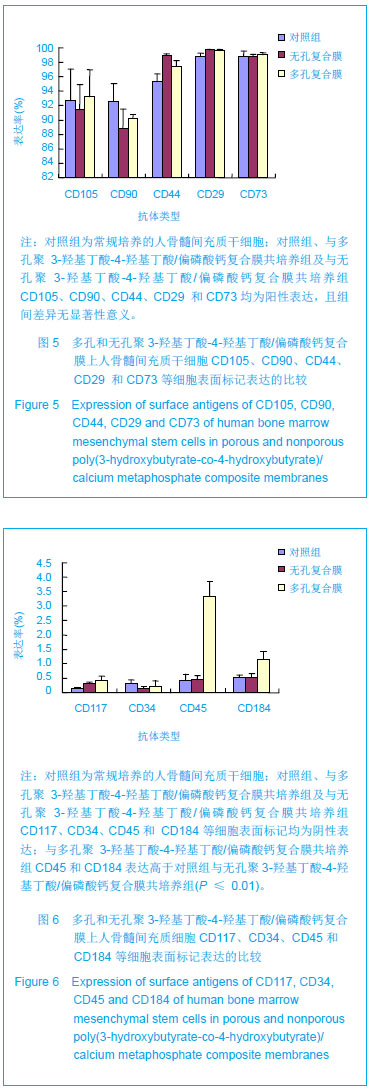
| [1]Rippel RA,Ghanbari H,Seifalian AM.Tissue-engineered heart valve: future of cardiac surgery. World J Surg.2012; 36(7): 1581-1591.[2]Colazzo F,Sarathchandra P,Smolenski RT,et al.Extracellular matrix production by adipose-derived stem cells: implications for heart valve tissue engineering. Biomaterials.2011;32(1): 119-127.[3]Yi F,Pereira L,Hoffman JA, et al. Opposing effects of Tcf3 and Tcf1 control Wnt stimulation of embryonic stem cell self-renewal. Nat Cell Biol.2011; 13(7):762-770.[4]Miki T,Yasuda SY,Kahn M.Wnt/beta-catenin signaling in embryonic stem cell self-renewal and somatic cell reprogramming. Stem Cell Rev.2011;7(4):836-846.[5]Banu MA,Shin BJ,Boockvar JA.Dissecting the perivascular stem-cell niche: can we take tumor recurrence down a NOTCH? Neurosurgery.2012;70(4):N18-19.[6]Nakamura S,Matsumoto T,Sasaki J,et al.Effect of calcium ion concentrations on osteogenic differentiation and hematopoietic stem cell niche-related protein expression in osteoblasts.Tissue Eng Part A.2010;16(8):2467-2473.[7]Aizawa Y,Shoichet MS.The role of endothelial cells in the retinal stem and progenitor cell niche within a 3D engineered hydrogel matrix. Biomaterials.2012; 33(21):5198-5205.[8]Lozoya OA,Wauthier E,Turner RA,et al.Regulation of hepatic stem/progenitor phenotype by microenvironment stiffness in hydrogel models of the human liver stem cell niche. Biomaterials.2011;32(30):7389-7402.[9]Lee ST,Yun JI,Jo YS,et al.Engineering integrin signaling for promoting embryonic stem cell self-renewal in a precisely defined niche. Biomaterials. 2010;31(6):1219-1226.[10]Weber B,Emmert MY,Hoerstrup SP.Stem cells for heart valve regeneration. Swiss. Med Wkly.2012;142:w13622.[11]Ye X,Hu X,Wang H,et al.Polyelectrolyte multilayer film on decellularized porcine aortic valve can reduce the adhesion of blood cells without affecting the growth of human circulating progenitor cells. Acta Biomaterialia.2012; 8(3):1057-1067.[12]Xin Y,Wang YM,Zhang H,et al.Aging adversely impacts biological properties of human bone marrow-derived mesenchymal stem cells: implications for tissue engineering heart valve construction.Artif Organs.2010;34(3):215-222.[13]Puceat M.Embryological origin of the endocardium and derived valve progenitor cells: From developmental biology to stem cell-based valve repair. Biochimt Biophy Acta. 2013; 1833(4):917-922.[14]Dainese L,Guarino A,Burba I, et al.Heart valve engineering: decellularized aortic homograft seeded with human cardiac stromal cells. J Heart Valve Dis.2012;21(1):125-134.[15]Martinez C,Rath S,Van Gulden S,et al.Periodontal ligament cells cultured under steady-flow environments demonstrate potential for use in heart valve tissue engineering. Tissue Eng Part A.2013;19(3-4):458-466.[16]Ramaswamy S,Gottlieb D,Engelmayr GC,et al.The role of organ level conditioning on the promotion of engineered heart valve tissue development in-vitro using mesenchymal stem cells. Biomaterials.2010;31(6):1114-1125.[17]Somers P,de Somer F,Cornelissen M,et al.Bioactive porcine matrices in heart valve tissue engineering. J Heart Valve Dis. 2012; 21(4):535-543.[18]Syedain ZH,Bradee AR,Kren S, et al.Decellularized Tissue-Engineered Heart Valve Leaflets with Recellularization Potential. Tissue Eng Part A.2013;19(5-6):759-769.[19]Eckert CE,Mikulis BT,Gottlieb D,et al.Three-dimensional quantitative micromorphology of pre- and post-implanted engineered heart valve tissues. Ann Biomed Eng. 2011;39(1): 205-222.[20]Chee JW,Amirul AA,Majid MI,et al.Factors influencing the release of Mitragyna speciosa crude extracts from biodegradable P(3HB-co-4HB).Int J Pharm.2008;361(1-2): 1-6.[21]Abou Neel EA,Chrzanowski W,Georgiou G, et al.In vitro biocompatibility and mechanical performance of titanium doped high calcium oxide metaphosphate-based glasses. J Tissue Eng.2010;2010:390127.[22]Park DH,Kim BS.Production of poly(3-hydroxybutyrate) and poly(3-hydroxybutyrate-co-4-hydroxybutyrate) by Ralstonia eutropha from soybean oil. N Biotechnol.2011;28(6): 719-724.[23]Navarro M,del Valle S,Martinez S, et al.New macroporous calcium phosphate glass ceramic for guided bone regeneration.Biomaterials.2004; 25(18):4233-4241.[24]吴岳恒,汤顺清,毛萱,等.组织工程支架材料偏磷酸钙玻璃陶瓷的多孔性能[J].中国组织工程研究与临床康复,2007,11(1): 130-132.[25]江燕萍,吴岳恒,成安衡.多孔偏磷酸钙生物材料的体外加速降解实验[J].中国组织工程研究与临床康复,2008,12(19):3663- 3666.[26]吴岳恒,张灵敏,曾祥君,等. 多孔聚3-羟基丁酸-4-羟基丁酸/偏磷酸钙复合膜的制备及降解性能[J].中国组织工程研究与临床康复,2011,15(51):9531-9534.[27]Gulfam M,Lee JM,Kim JE,et al.Highly porous core-shell polymeric fiber network. Langmuir .2011; 27(17):10993- 10999.[28]Lee HY,Jin GZ,Shin US,et al.Novel porous scaffolds of poly(lactic acid) produced by phase-separation using room temperature ionic liquid and the assessments of biocompatibility. J Mater Sci Mater Med. 2012;23(5):1271- 1279.[29]Fromstein JD,Zandstra PW,Alperin C,et al.Seeding bioreactor-produced embryonic stem cell-derived cardiomyocytes on different porous, degradable, polyurethane scaffolds reveals the effect of scaffold architecture on cell morphology. Tissue Eng Part A. 2008; 14(3): 369-378.[30]Ehlicke F,Freimark D,Heil B,et al.Intervertebral disc regeneration: influence of growth factors on differentiation of human mesenchymal stem cells (hMSC).Int J Artif Organs. 2010;33(4):244-252.[31]Weber C,Pohl S,Portner R,et al.Cultivation and Differentiation of Encapsulated hMSC-TERT in a Disposable Small-Scale Syringe-Like Fixed Bed Reactor. T Open Biomed Eng J.2007; 1:64-70.[32]Kim J,Ma T.Perfusion regulation of hMSC microenvironment and osteogenic differentiation in 3D scaffold. Biotechnol Bioeng. 2012; 109(1):252-261.[33]Calarco A,Petillo O,Bosetti M,et al.Controlled delivery of the heparan sulfate/FGF-2 complex by a polyelectrolyte scaffold promotes maximal hMSC proliferation and differentiation. J Cell Biochem. 2010; 110(4):903-909.[34]Dickinson LE, Kusuma S, Gerecht S.Reconstructing the differentiation niche of embryonic stem cells using biomaterials. Macro Biosci.2011; 11(1):36-49.[35]Hoshikawa A,Fukui N,Fukuda A, et al.Quantitative analysis of the resorption and osteoconduction process of a calcium phosphate cement and its mechanical effect for screw fixation. Biomaterials.2003;24(27):4967-4975.[36]Walschot LH,Aquarius R,Schreurs BW,et al.Osteoconduction of impacted porous titanium particles with a calcium-phosphate coating is comparable to osteoconduction of impacted allograft bone particles: In vivo study in a nonloaded goat model. J Biomed Mater Res B Appl Biomater. 2012;100(6):1483-1489.[37]Svinareva DA,Shipunova IN,Ol'shanskaia Iu V, et al.The basic properties of mesenchymal stromal cells from the donor bone marrow: superficial markers. Ter Arkh. 2010;82(7):52-56.[38]Son BR,Marquez-Curtis LA,Kucia M,et al.Migration of bone marrow and cord blood mesenchymal stem cells in vitro is regulated by stromal-derived factor-1-CXCR4 and hepatocyte growth factor-c-met axes and involves matrix metalloproteinases. Stem Cells.2006;24(5):1254-1264.[39]Sharma M, Afrin F, Satija N, et al.Stromal-derived factor-1/CXCR4 signaling: indispensable role in homing and engraftment of hematopoietic stem cells in bone marrow. Stem Cells Dev. 2011;20(6):933-946.[40]Zannettino AC,Paton S,Kortesidis A,et al.Human mulipotential mesenchymal/stromal stem cells are derived from a discrete subpopulation of STRO-1bright/CD34 /CD45(-)/ glycophorin-A-bone marrow cells. Haematologica. 2007; 92(12): 1707-1708.[41]Yeh SP,Chang JG,Lo WJ,et al.Induction of CD45 expression on bone marrow-derived mesenchymal stem cells. Leukemia. 2006;20(5):894-896. |
| [1] | Ma Zhijie, Li Jingyu, Cao Fang, Liu Rong, Zhao Dewei. Influencing factors and biological property of novel biomedical materials: porous silicon carbide coated with bioactive tantalum [J]. Chinese Journal of Tissue Engineering Research, 2021, 25(4): 558-563. |
| [2] | Li Li, Ma Li. Immobilization of lactase on magnetic chitosan microspheres and its effect on enzymatic properties [J]. Chinese Journal of Tissue Engineering Research, 2021, 25(4): 576-581. |
| [3] | Zhou Anqi, Tang Yufei, Wu Bingfeng, Xiang Lin. Designing of periosteum tissue engineering: combination of generality and individuality [J]. Chinese Journal of Tissue Engineering Research, 2021, 25(22): 3551-3557. |
| [4] | Lang Limin, He Sheng, Jiang Zengyu, Hu Yiyi, Zhang Zhixing, Liang Minqian. Application progress of conductive composite materials in the field of tissue engineering treatment of myocardial infarction [J]. Chinese Journal of Tissue Engineering Research, 2021, 25(22): 3584-3590. |
| [5] | Zhang Hui, Wang Shaohua, Wang Qian, Wang Hui, Gan Hongquan, Cui Yishuang, Li Qijia, Wang Zhiqiang. Porous tantalum coated with RGD polypeptide can activate the integrin/focal adhesion kinase signaling pathway of MG63 cells [J]. Chinese Journal of Tissue Engineering Research, 2021, 25(16): 2535-2540. |
| [6] | Xie Jian, Su Jiansheng. Advantages and characteristics of electrospun aligned nanofibers as scaffolds for tissue engineering [J]. Chinese Journal of Tissue Engineering Research, 2021, 25(16): 2575-2581. |
| [7] | Ji Qi, Yu Zhengwen, Zhang Jian. Problems and trends of technique and clinical application of metallic biomaterials prepared by three-dimensional printing technology [J]. Chinese Journal of Tissue Engineering Research, 2021, 25(16): 2597-2604. |
| [8] | Qian Nannan, Zhang Qian, Yang Rui, Ao Jun, Zhang Tao. Mesenchymal stem cells in the treatment of spinal cord injury: cell therapy and combination of new drugs and biomaterials [J]. Chinese Journal of Tissue Engineering Research, 2021, 25(13): 2114-2120. |
| [9] | Jia Wei, Zhang Mandong, Chen Weiyi, Wang Chenyan, Guo Yuan. Effects of femoral prosthetic materials on artificial knee arthroplasty performance [J]. Chinese Journal of Tissue Engineering Research, 2021, 25(10): 1477-1481. |
| [10] | Wang Qian, Li Lu, Shu Jingyuan, Dong Zhiheng, Jin Youshi, Wang Qingshan. Micro-morphology and phase of zirconia-based nano-hydroxyapatite functional gradient biomaterials [J]. Chinese Journal of Tissue Engineering Research, 2021, 25(10): 1517-1521. |
| [11] | Zhao Chuntao, Qing Mingsong, Yu Langbo, Peng Jiachen . Meta-analysis of total knee arthroplasty guided by kinematic alignment and mechanical alignment [J]. Chinese Journal of Tissue Engineering Research, 2020, 24(9): 1435-1442. |
| [12] |
Zhang Cong, Zhao Yan, Du Xiaoyu, Du Xinrui, Pang Tingjuan, Fu Yining, Zhang Hao, Zhang Buzhou, Li Xiaohe, Wang Lidong.
Biomechanical analysis of the lumbar spine and pelvis in adolescent
idiopathic scoliosis with lumbar major curve |
| [13] |
Cen Yanhui, Xia Meng, Jia Wei, Luo Weisheng, Lin Jiang, Chen Songlin, Chen Wei, Liu Peng, Li Mingxing, Li Jingyun, Li Manli, Ai Dingding, Jiang Yunxia.
Baicalein inhibits the biological behavior of hepatocellular
carcinoma stem cells by downregulation of Decoy receptor 3 expression |
| [14] | He Yujie, Wang Haiyan, Li Zhijun, Li Xiaohe, Cai Yongqiang, Dai Lina, Xu Yangyang, Wang Yidan, Xu Xuebin. Digital measurements of the anatomical parameters of pedicle-rib unit screw fixation in thoracic vertebrae of preschoolers [J]. Chinese Journal of Tissue Engineering Research, 2020, 24(6): 869-876. |
| [15] | Yan Shu, Lu Yan, Ouyang Zhaolian. Analysis of programs on tissue engineering funded by the National Natural Science Foundation of China between 2013 and 2018 [J]. Chinese Journal of Tissue Engineering Research, 2020, 24(5): 731-735. |
| Viewed | ||||||
|
Full text |
|
|||||
|
Abstract |
|
|||||
